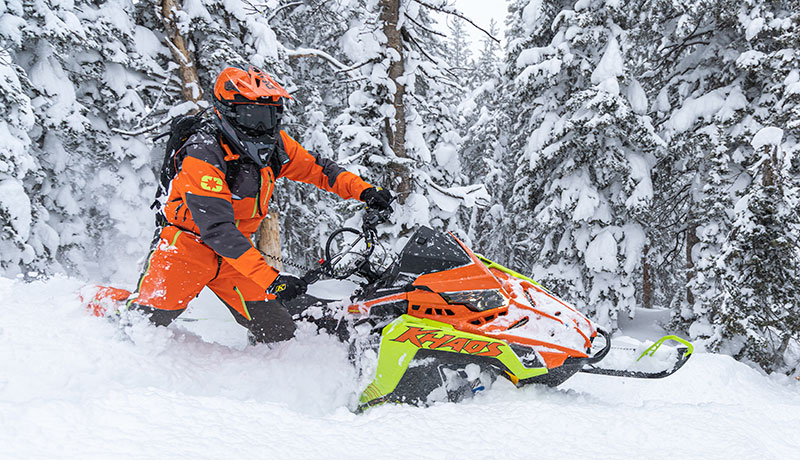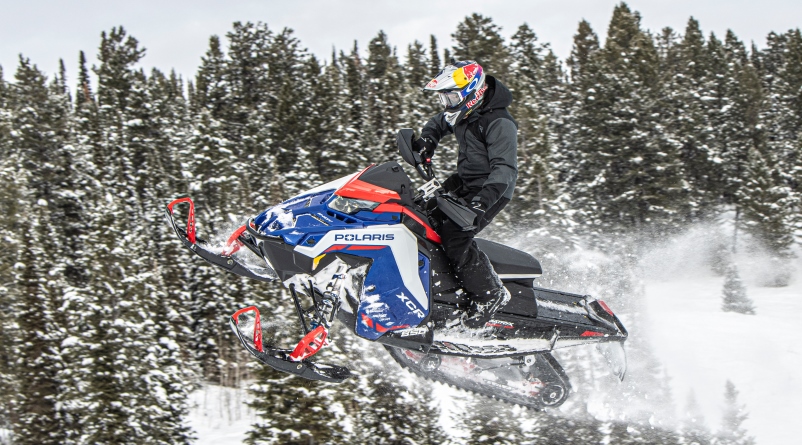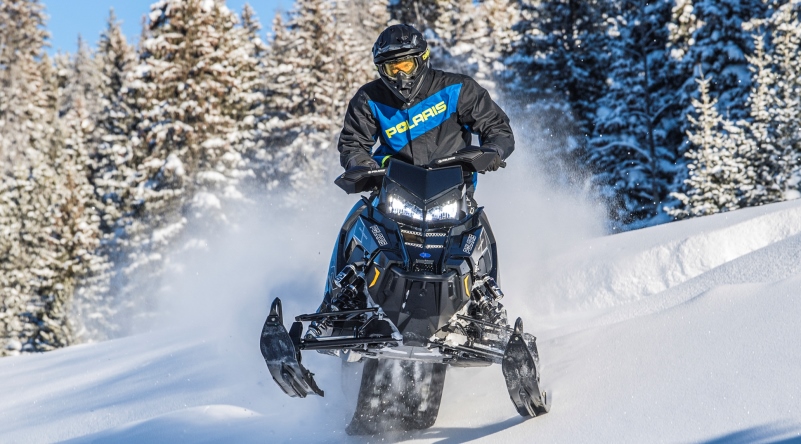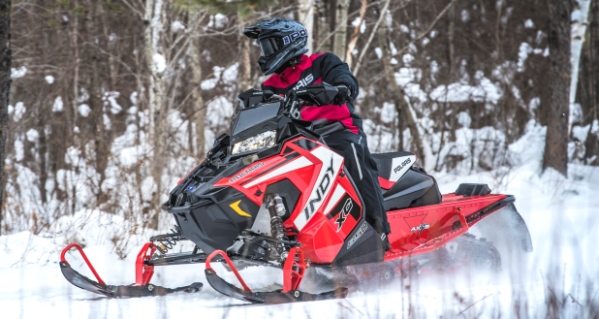One word comes to mind when evaluating the 600 Rush Pro-R from Polaris: Responsive.
Every input that is sent into the sled is felt, for good or ill. A touch on the throttle creates an immediate response as power surges through the efficient clutching with lightning speed, creating a quick burst forward. A touch on the brake lever also produces quick action. Similarly, driver inputs into the chassis have a very direct impact — a pull on the bars, a lean here, a tug there. Body positioning, throttle inputs and the sled’s light weight allow an active rider to bound with this sled as much as ride it.
The rear suspension also provides a lot of feedback to the rider; in many conditions, that’s great, as the rider gets to act as an extension of a machine that rarely bottoms and is truly playful. On Sunday afternoon trails with repetitive stutter bumps, however, the Pro-Ride rear can be more tiring and less comfortable than some setups, most particularly the rMotion-equipped Ski-Doos.
Back for its fourth season on the snow for Polaris, the 2013 Rush models continue to evolve. For the new year, the Pro-R gets new Pro-Steer skis that improve handling and steering effort, a softer seat that makes a marked improvement in rider comfort and a one-piece handlebar that allows for heat in the hooks — pinky fingers rejoice! There was also a revision in the engine setup, as it switched from a four-injector to a two-injector setup.
Take it from guys who actively seek letters to the editor for our magazine – we like feedback. But does this Polaris offer the right kinds, at the right time?
How It Fits

Sometimes little things add up, and they do with the 2013 Rush models.
It starts with the seat. Polaris engineers removed the narrow, stiff and aggressive perch from its hero models and replaced it with the more plush and slightly wider-at-the-saddle seat that was introduced on 2012 Pro-Ride Switchback models. Even our most aggressive riders who previously thought they needed a racer-type seat really appreciated the added comfort of this new setup.
Still, when behind the bars on the Rush, the rider sits rather tall on a seat that feels comparatively short (lengthwise) to some other models. Even though the seat is wider at the center, its tapered design makes it easy to hang off in turns and lean forward and into the seat. We’re sure the measured center-of-gravity change is miniscule, but it felt like we could get our weight farther out and forward, wrapping a knee around the side panel.
The new one-piece handlebar doesn’t change the ergos much, but it does create a more finished look and incorporates an updated throttle block and kill switch on the right side. The left side of the bars, however, still features the 1990s-era hand and thumb warmer sliders that are clunky to operate, thanks to small switches and minimal detents. It seems like Polaris should have moved past this setup long ago. The height of the bars and aggressive running board trim make this an easy sled to ride standing up, and we’ve really come to appreciate the kick-ups at the back of the boards. Some riders find the bars too wide, however.
Rush drivers sit “into” the chassis more than on other sleds, thanks to higher front body panels, feeling more integrated into the experience as opposed to sitting “over” the Ski-Doo or “on” the spacious Cat, for example. This, plus the standard mid-height windshield makes the Rush the warmest sled of this foursome on a cold day, though certainly a lot of wind still gets to the driver. In fact, this is the only sled in this class without hand guards.
How It Performs

The responsiveness that we referred to earlier is evident from the first tap of the throttle. The 599cc, liquid-cooled, Cleanfire semi-direct injection engine comes to life immediately, quickly forcing the power through the clutches and to the ground through the uncoupled Pro-Ride rear suspension, which transfers weight expertly.
There have been some changes under the hood — Polaris went with a two-injector system that it says is cleaner, less costly and more efficient, and thus has lower emissions. The changes, first found on last year’s 600 RMK, include updated fuel rails, injectors, exhaust and settings in the engine management system. Polaris engineers said we shouldn’t expect to feel any difference in the sled’s powerband over last year’s four-injector setup, and we didn’t — it was still hyper reactive, more than one would expect from a sled with 120ish horsepower. Rush Pro-R models keep the hollow jackshaft and lightweight rotor to differentiate them from the base Rush units.
We’ve long raved about the Pro-Ride front suspension, particularly for the way it tracks straighter than any other design through rutted out sections on and off the trail. Pre-2012 Rush models, however, featured excessive ski lift that could lead to an unplanned wrestling match. A re-positioned front torque arm and Race IFS geometry above the skis for 2012 erased that issue, and now new Pro-Steer skis add further confidence up front. Handling is a modicum better and the steering is a bit lighter, although it still requires more shoulder effort than some others in this class.
The unique Pro-Ride rear suspension continues to get a mixed review from our crew. It provides a bottomless feel, straight tracking and an active and fun ride when on the gas through big moguls. Its quick transfer allows riders to really get playful with this snowmobile when jumping over snowbanks or pounding up and down ungroomed powerlines trails, for example. Those are the advantages of the Rush’s uncoupled rail design.

The disadvantage shows up on beat-up trails with unending, repetitive stutter bumps, and over the course of the week we found plenty of those in which to run Pro-Ride-equipped Polaris snowmobiles. The overall balance of the sled allowed us to chop through these sections confidently, as it tracked straight and there was never a surprise or late, mid-corner correction needed. But the rider on the Polaris definitely took more abuse from the bumps than on other sleds, most particularly the Ski-Doo, which seemed to erase the energy. The Rush could be downright jarring.
Both the front and rear suspension rely on adjustable Walker Evans shocks, with piggybacks at the front and center and a remote reservoir on the rear arm. The Polaris Phantom brake continues to be our favorite binder.
Final Grade
If you can’t tell by now, we really like the Rush. Its overall fun factor rated highest among our test team, and it was singled out as the favorite by three of our five test riders. And, at $10,799, it’s also at least $650 less expensive than others in this class.
But the dichotomy of the rear suspension brings us back to the word “responsive.” On smooth trails, it handled extremely well, was easy to move around on and was as good as anything out there. In really big bumps, it was fun, exciting, tracked straight and rarely bottomed. In common chop, however, the Polaris was definitely outclassed by other sleds in this comparison.
It’s an interesting trade-off: If you’re willing to accept some harshness in these situations for arguably the most fun trail runner on snow, this could be the ride for you. If, however, chopping through Sunday afternoon trails is the kryptonite to you being Superman, then the Ski-Doo would be a better selection.
Polaris 600 Rush Pro-R / $10,799
ENGINE: 599cc, liquid-cooled, two-stroke twin with Cleanfire semi-direct injection SUSPENSION: Pro-Ride dual A-arm front suspension with Walker Evans piggyback shocks, 9 inches of travel; Pro-Ride rear with Walker Evans shocks, 14 inches of travel DIMENSIONS: 108 inches long by 48 inches wide, 464 pounds dry; 15x121x1.25 RipSaw track STANDARD FEATURES: Push-button reverse, mid-height windshield, push-button reverse NEW FOR 2013: Pro-Steer ski, Pro-Ride Adventure seat, one-piece handlebar with integrated hooks, two-injector fuel system
See how the Arctic Cat ProCross performs compared to other sleds in the 600-Class shootout!






